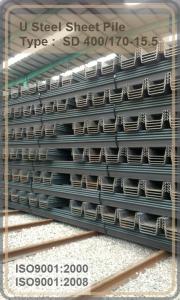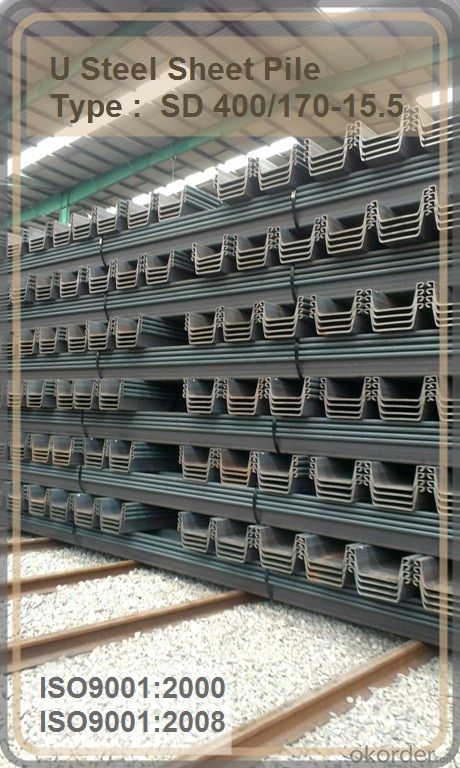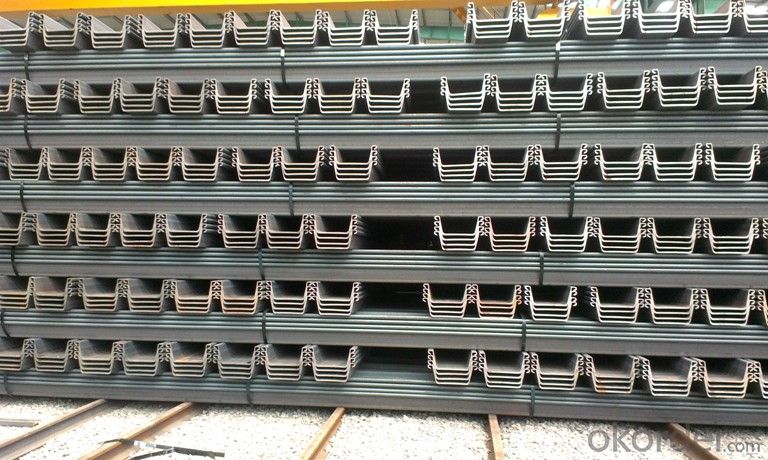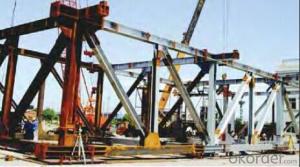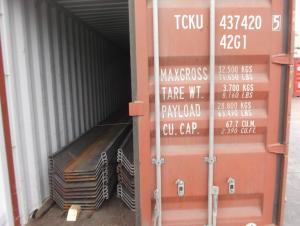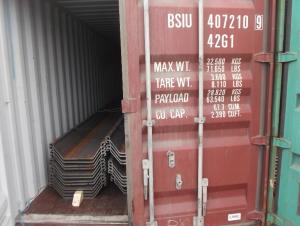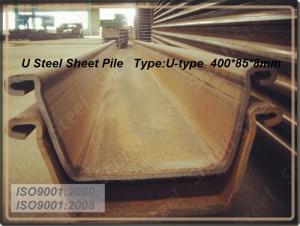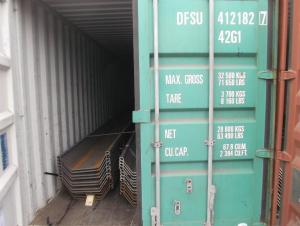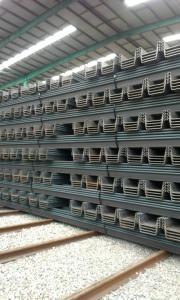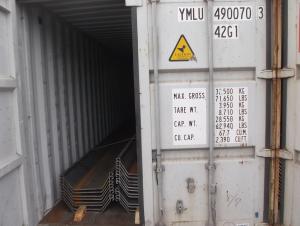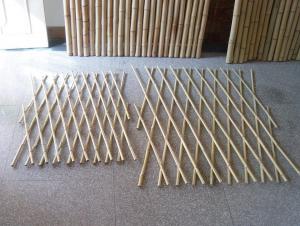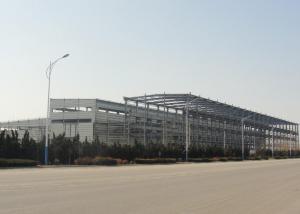U Steel Sheet Pile/ 400*170*15.5mm/ Export Steel Sheet Pile
- Loading Port:
- China Main Port
- Payment Terms:
- TT or LC
- Min Order Qty:
- 200 Piece/Pieces m.t.
- Supply Capability:
- 10000 m.t./month
OKorder Service Pledge
OKorder Financial Service
You Might Also Like
Quick Details for U Steel Sheet Pile
Place of Origin: China (Mainland)
Model Number: SD400/170-15.5
Material: Steel
Product name: Steel Sheet Pile
Steel sheet pile type: U-type
Steel sheet pile material: SY295
Steel sheet pile width: 400mm
Steel sheet pile height: 170mm
Steel sheet pile thickness: 15.5mm
Steel sheet pile length: 6m or 12m
Steel sheet pile loading: container , 20 ft or 40GP
Steel sheet pile used: temporary earth-retaining,temporary cofferdam works
Steel sheet pile weight: 76.1kgs / m
Packaging & Delivery
| Packaging Details: | packaging :by bulk . loading : container 20ft or 40GP |
|---|---|
| Delivery Detail: | stock ( more type has stock ) |
Specifications
Steel Sheet Pile 400*170*15.5mm
U Steel Sheet Pile
temporary earth-retaining/temporary cofferdam works/permanent structures
Export U Steel Sheet Pile 400*170*15.5mm
Product Description
Steel Sheet Pile usage
emporary earth-retaining, temporary cofferdam works and permanent structures
U Steel Sheet Pile Type : SD 400/170-15.5
Type | Size | Per piece | Per Meter of pile wall | ||||||||
Width | Height | Thickness | weight | section area | section moment | section modulus | section area | section moment | section modulus | weight | |
mm | mm | mm | kgs /m | cm2 | cm4 | cm3 | cm²/m | cm4/m | Cm³/m | kg/m² | |
SD400/85-8 | 400 | 85 | 8 | 35.5 | 45.21 | 598 | 88 | 113 | 4500 | 529 | 88.80 |
SD400/100-10.5 | 400 | 100 | 10.5 | 48 | 61.18 | 1240 | 152 | 153 | 8740 | 874 | 120.10 |
SD400/125-13 | 400 | 125 | 13 | 60 | 76.42 | 2220 | 223 | 191 | 16800 | 1340 | 149.90 |
SD400/150-13.1 | 400 | 150 | 13.1 | 58.4 | 74.4 | 2790 | 250 | 186 | 22800 | 1520 | 146.00 |
SD400/170-15.5 | 400 | 170 | 15.5 | 76.1 | 96.99 | 4670 | 362 | 242.5 | 38600 | 2270 | 190.40 |
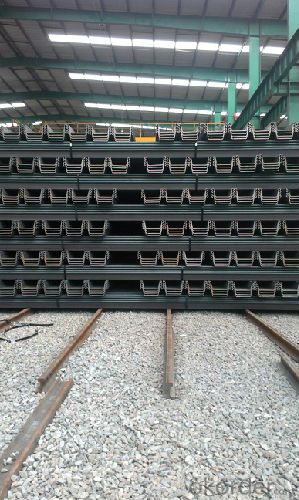
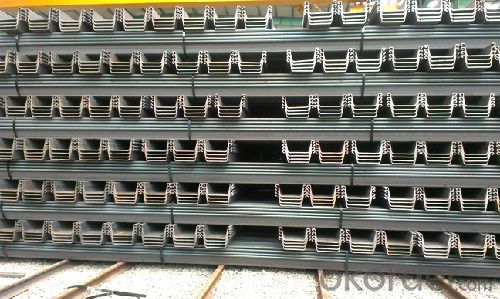
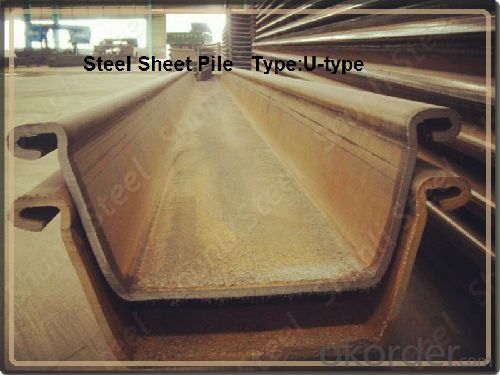
Packaging & Shipping
Packing for Steel Sheet Pile: it use container to load , 6M use 20ft container ; 12M use 40GP container .
- Q: How does the quality of steel affect the strength of a structure?
- The quality of steel directly affects the strength of a structure. Higher quality steel, which is typically made with a higher percentage of carbon and other alloying elements, has improved mechanical properties such as higher tensile strength and greater resistance to deformation. This means that structures built with higher quality steel can withstand higher loads and are less likely to fail or deform under stress. Conversely, lower quality steel may have lower strength and may be more prone to failure or structural instability. Therefore, the quality of steel is a critical factor in determining the overall strength and durability of a structure.
- Q: What are the considerations for designing steel structures for adaptive reuse projects?
- When designing steel structures for adaptive reuse projects, there are several key considerations to keep in mind. Firstly, it is important to assess the structural integrity and load-bearing capacity of the existing steel framework. This includes evaluating the condition of the steel members, connections, and overall stability. Additionally, the design should account for any modifications or additions needed to meet the new functional requirements of the adaptive reuse project. This may involve reconfiguring the layout, adding new floors or openings, or reinforcing the existing structure to support added loads. Another consideration is the compatibility of the steel structure with the desired aesthetic and design goals of the adaptive reuse project. This may involve preserving and showcasing the existing steel elements as architectural features or integrating new steel components harmoniously. Furthermore, sustainable design principles should be considered, such as incorporating energy-efficient systems, utilizing recycled steel, and optimizing the use of natural light and ventilation. Lastly, compliance with local building codes and regulations is crucial to ensure the safety and legality of the adaptive reuse project. This includes ensuring fire safety, accessibility, and meeting seismic requirements. Overall, designing steel structures for adaptive reuse projects requires a comprehensive understanding of the existing structure, functional requirements, design goals, sustainability considerations, and compliance with building codes.
- Q: What are the aesthetic possibilities of steel structures?
- The aesthetic possibilities of steel structures are extensive and diverse. Steel offers a sleek, modern, and industrial aesthetic that can be tailored to various architectural styles and design preferences. With its inherent strength and flexibility, steel allows for the creation of unique and innovative shapes, curves, and forms that would be challenging with other materials. Additionally, steel structures can be finished with a variety of coatings, paints, and textures, providing further opportunities for customization and enhancing the overall visual appeal. Whether it's through the use of bold, minimalist designs or intricate detailing, steel structures have the potential to create striking and visually captivating architectural compositions.
- Q: How are steel structures used in cultural and religious buildings?
- Steel structures are widely used in cultural and religious buildings for several reasons. Firstly, steel offers superior strength and durability, which is crucial for constructing large and complex structures that often serve as iconic symbols of cultural identity or religious significance. In cultural buildings like museums or art galleries, steel structures allow for large open spaces and flexible layouts, enabling the display of various exhibits and artwork. The use of steel beams and columns provides the necessary support to create vast open areas without the need for excessive columns or walls, allowing for a more visually appealing and immersive experience for visitors. Religious buildings, such as churches, cathedrals, or temples, often require soaring heights and intricate designs to evoke a sense of spirituality and grandeur. Steel structures allow architects and engineers to achieve these architectural feats by providing the necessary strength and stability. The use of steel also facilitates the incorporation of large stained glass windows, intricate ornamentation, and decorative elements, which are often crucial in religious buildings. Moreover, steel structures offer flexibility in terms of design and construction. They can be easily prefabricated off-site, ensuring precision and reducing construction time. This versatility allows for the creation of unique and innovative designs that reflect the cultural or religious values of the community. Additionally, steel structures are known for their sustainability. Steel is a recyclable material, and its use in construction reduces the need for other materials such as concrete or wood, which have a higher environmental impact. This aspect aligns well with the values of many cultural and religious organizations that prioritize environmental stewardship and sustainability. In conclusion, steel structures play a pivotal role in cultural and religious buildings by providing the necessary strength, flexibility, and sustainability. They enable the creation of awe-inspiring designs, large open spaces, and intricate details that reflect the cultural or religious identity of the community. Whether it is a museum, a church, or a temple, steel structures contribute to the construction of spaces that evoke a sense of wonder, spirituality, and cultural heritage.
- Q: How are steel structures designed for water treatment facilities?
- Steel structures for water treatment facilities are designed with several key considerations in mind. First, they must be able to withstand the corrosive effects of water and chemicals used in the treatment process. This requires the use of corrosion-resistant materials and protective coatings. Secondly, the structures need to be able to support heavy equipment and machinery used in the treatment process, and be designed to withstand any dynamic loads. Additionally, factors such as seismic activity and extreme weather conditions are taken into account during the design process. Overall, steel structures for water treatment facilities are carefully planned and engineered to ensure durability, safety, and efficient operation of the facility.
- Q: How are steel structures designed for efficient use of renewable energy sources?
- There are several ways in which steel structures can be designed to effectively utilize renewable energy sources. Firstly, solar panels can be integrated into the structure's design, either on the roof or walls. These panels can capture sunlight and convert it into electricity, which can be used to power the building or be fed back into the grid. By incorporating solar panels, the building can generate clean and sustainable energy, reducing its reliance on fossil fuels. Moreover, steel structures can be designed to optimize natural lighting and ventilation. Strategically placed large windows and skylights allow for ample natural light, decreasing the need for artificial lighting during the day. This not only saves energy but also creates a pleasant and productive indoor environment. In terms of ventilation, steel structures can be designed with features such as operable windows or louvers that facilitate natural airflow. This promotes natural cooling and reduces the necessity for air conditioning, especially in moderate climates. By leveraging natural ventilation, the building can minimize its energy consumption and dependence on mechanical cooling systems. Another method to efficiently utilize renewable energy sources in steel structures is by integrating wind turbines. These turbines can be installed on the roof or adjacent to the building, harnessing the power of wind to generate electricity. Vertical axis wind turbines are particularly suitable for urban environments and can be easily incorporated into the design of steel structures. Finally, steel structures can also be designed to capture and reuse rainwater. By integrating rainwater harvesting systems into the building's design, rainwater can be collected and stored for non-potable uses such as irrigation or toilet flushing. This reduces the demand for freshwater and conserves water resources. In conclusion, steel structures can be designed in various ways to effectively utilize renewable energy sources. By incorporating solar panels, maximizing natural lighting and ventilation, integrating wind turbines, and implementing rainwater harvesting systems, these structures can significantly reduce their carbon footprint and contribute to a more sustainable and environmentally friendly built environment.
- Q: What is the difference between structural steel and reinforcing steel?
- Construction projects rely on both structural steel and reinforcing steel, which have distinct roles and characteristics. Structural steel, also called mild steel or carbon steel, is primarily used in building construction and bridges. It is a durable material with high tensile strength, capable of withstanding heavy loads. Manufacturers create structural steel in various shapes like beams, columns, and plates, and it is often fabricated and welded to form complex structures. It provides the framework and support for the entire structure, ensuring stability and integrity. In contrast, reinforcing steel, also known as rebar, reinforces concrete structures. Its main purpose is to enhance the strength and durability of concrete, which is relatively weak in tension. By embedding reinforcing steel within concrete, the resulting composite material, known as reinforced concrete, becomes much stronger and able to withstand greater tensile forces. Rebar comes in different diameters and is usually placed in a grid-like pattern before pouring concrete. This creates a reinforced grid, preventing cracking or failure and providing additional strength. In summary, the difference between structural steel and reinforcing steel lies in their applications and functions. Structural steel serves as the primary load-bearing material, ensuring strength and stability. Reinforcing steel, on the other hand, strengthens and reinforces concrete structures, improving their ability to resist tension and other forces. Both materials are essential in construction, playing vital roles in ensuring the safety and longevity of various structures.
- Q: How do steel structures handle different weather conditions?
- Steel structures are designed to withstand different weather conditions due to the inherent properties of steel. Steel is known for its strength, durability, and resistance to corrosion, making it suitable for all types of climates. It can handle extreme heat, cold, high winds, heavy rains, and even seismic activity. Additionally, steel structures can be designed to accommodate expansion and contraction caused by temperature variations, ensuring their stability and safety in diverse weather conditions.
- Q: What are the design considerations for steel transmission towers?
- To ensure the structural integrity, reliability, and efficient performance of steel transmission towers, several key considerations must be taken into account during the design process. These considerations can be categorized into different aspects, including load capacity, material selection, structural design, environmental factors, and maintenance and inspection requirements. Load capacity is a crucial factor in the design of steel transmission towers. It involves designing the towers to withstand various loads, such as dead loads, live loads, and dynamic loads. These loads include the weight of the tower structure and its components, wind, ice, earthquake loads, and loads induced by conductor movement or line faults. By considering these loads, structural failure can be prevented, and long-term stability can be ensured. The selection of the right material is also important in designing steel transmission towers. Steel is commonly used due to its strength, durability, and cost-effectiveness. When choosing the type of steel, factors like yield strength, ductility, and corrosion resistance should be taken into consideration. The selection of the appropriate steel grade and protective coatings can enhance the tower's resistance to environmental conditions, such as corrosion in coastal or industrial areas. Structural design involves determining the optimal size, shape, and configuration of the tower components to meet load requirements. This includes optimizing the tower's height, base width, leg profile, and cross-sectional shape to ensure stability, minimize material usage, and facilitate ease of construction. Other factors, such as tower grounding, foundation design, and the connection between tower segments, should also be considered. Environmental factors play a significant role in the design of steel transmission towers. Wind, for example, is a critical factor that towers must be designed to withstand based on local regulations and site-specific conditions. In colder climates, ice accumulation can increase the load on the tower and must be considered. Temperature variations, seismic activity, and soil conditions should also be evaluated during the design process. Maintenance and inspection should also be taken into account during the design phase. Designing towers with suitable access points, ladder systems, and platforms can facilitate safe and efficient tower inspections and repairs. By considering maintenance provisions in the design, the service life of the towers can be extended, and downtime can be minimized. In conclusion, the design considerations for steel transmission towers encompass load capacity, material selection, structural design, environmental factors, and maintenance requirements. By carefully addressing these considerations, engineers can create robust and reliable transmission towers that meet the needs of the electrical grid while ensuring public safety and minimizing operational costs.
- Q: How does steel perform in terms of wind resistance?
- Steel performs exceptionally well in terms of wind resistance. Its high strength and rigidity allow it to withstand strong winds and resist deformation or collapse. Steel structures are often used in buildings, bridges, and offshore platforms to provide a robust and safe solution against wind loads. Additionally, steel's ability to be engineered and shaped into various forms allows for efficient and aerodynamic designs, further enhancing its performance in windy conditions.
Send your message to us
U Steel Sheet Pile/ 400*170*15.5mm/ Export Steel Sheet Pile
- Loading Port:
- China Main Port
- Payment Terms:
- TT or LC
- Min Order Qty:
- 200 Piece/Pieces m.t.
- Supply Capability:
- 10000 m.t./month
OKorder Service Pledge
OKorder Financial Service
Similar products
Hot products
Hot Searches
Related keywords
